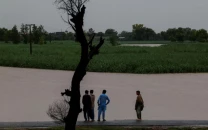Trail 6 declared leopard preservation zone
Sherry Rehman says initiative aims to provide natural habitat for endangered wildcat

The Ministry of Climate Change has declared Trail-6 at the Margalla Hills National Park (MHNP) a dedicated leopard preservation zone.
The preservation zone for common Asian leopards has been allocated in the Kalinjer area of Trail-6.
“We have closed off trail 6 of Margalla Hills National Park to make it a unique leopard preserve in the heart of the capital. It is Pakistan and the Climate Change Ministry’s most important and successful initiative to enhance our biodiversity and reverse some of the human encroachments,” said Minister for Climate Change Sherry Rehman in a video she shared on her Twitter handle.
The minister said: “The new leopard preserve nestled in the capital is an index of our commitment to growing biodiversity, expanding the natural habitats of big cats which are “ecosystems engineers”. This is their space we humans encroached on, let’s share the earth with them, not drive them out.”
“We do open this zone for guided tours in the hope that we can keep our wildlife in the state it is meant to be - free and easy to roam in their natural habitat. Big cats and leopards are ecosystem engineers, they preserve the habitat in a unique way and maintain its system,” she said.
Rehman said that “If you want to enhance biodiversity and reverse terrible encroachment on wildlife and species under threat, it is time for us to work on trails and habitats such as these. I'm very proud to say it is one of our biggest successes and I thank wildlife rangers & everyone involved in this.”
Islamabad Wildlife Management Board (IWMB) officials said that the conservation site would help protect critically endangered wildcats and promote wildlife tourism in one of the unique ecosystems close to a human settlement.
They said that the Trail-6 would no more be an open trail due to the presence of leopards, estimated to be between six to eight.
Last week, the body of a leopard was found in a ravine in the Kalinjer area behind last week and IWMB officials said that the wildcat died of natural causes.
The National Veterinary Hospital, Ministry of National Food Security and Research, did not find any traces of poison in its postmortem report.
According to the report, the heart, lungs, kidney, liver and other parts of the leopard had been sent to the laboratory to ascertain if the leopard had been poisoned by the local villagers after it was spotted at the Saidpur Village of Islamabad.
There were fears that villagers might have poisoned the predator especially after it was spotted on a rooftop of a house in Saidpur village.
On November 19, around four common Asian Leopards were spotted in the model village of Saidpur which caused fear and panic among residents.
The endangered big cats reportedly intruded into the village located next to the protected area in the evening and hunted a goat.
The IWMB staff was also rushed to the spot to ensure the protection of the public and the wild species.
Earlier, IWMB Chairperson Rina Saeed Khan said that leopards not so common anymore, because they were being killed mercilessly. "They were once found all over Pakistan, in almost all the provinces, and now the numbers are declining very fast because of loss of habitat, because of poaching, because of people hunting them for their skin, for their trophies."
In recent years, there have been signs of a leopard comeback in the park located just outside of Islamabad.
Conservationists say the animals likely drifted to the Margalla area - foothills of the Himalayan mountains - as it became heavily forested over the years. And they stayed on because they found prey, a stable environment and an ecosystem that could support them.
IWMB officials said leopards have become permanent residents of Margalla Hills National Park. The animal earlier used it to descend from the upper peaks in winter, they said.
The officials said that over 300 birds, 350 plants and 20 snake species can be found at the Margalla Hills National Park which make it a biodiversity-rich ecosystem.
Rina Saeed earlier said that a minimum of seven leopards had been captured by the cameras and there were probably more of them there.
“Trail-6 was shut after the spotting of the first leopard and during the Covid-19 lockdown, and its biodiversity thrived which increased the animal's population," she added.
Published in The Express Tribune, December 12th, 2022.



















COMMENTS
Comments are moderated and generally will be posted if they are on-topic and not abusive.
For more information, please see our Comments FAQ